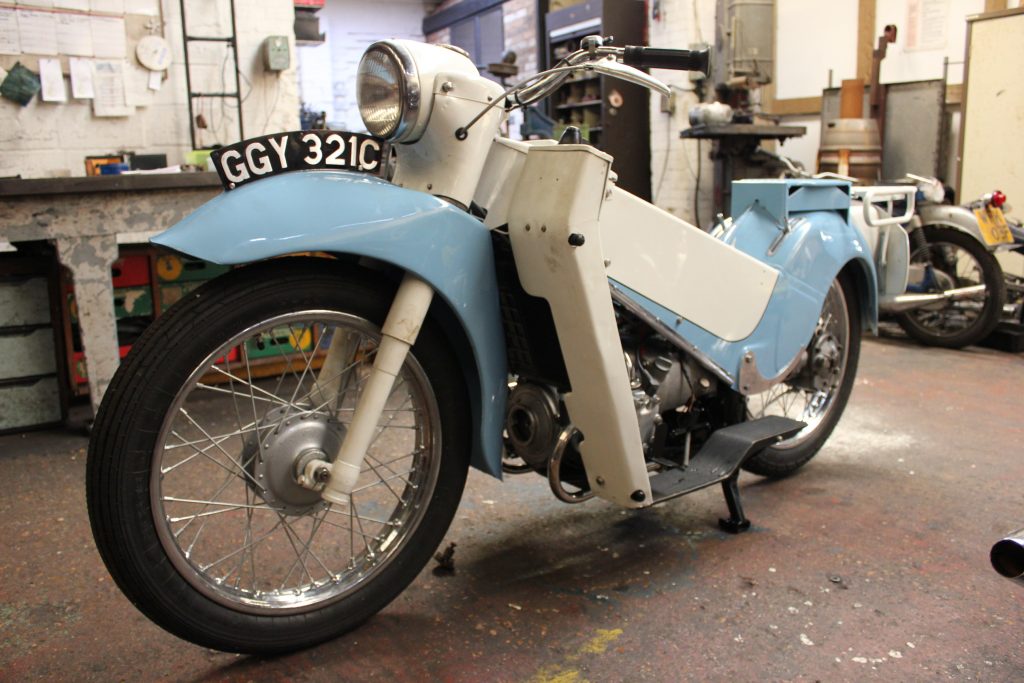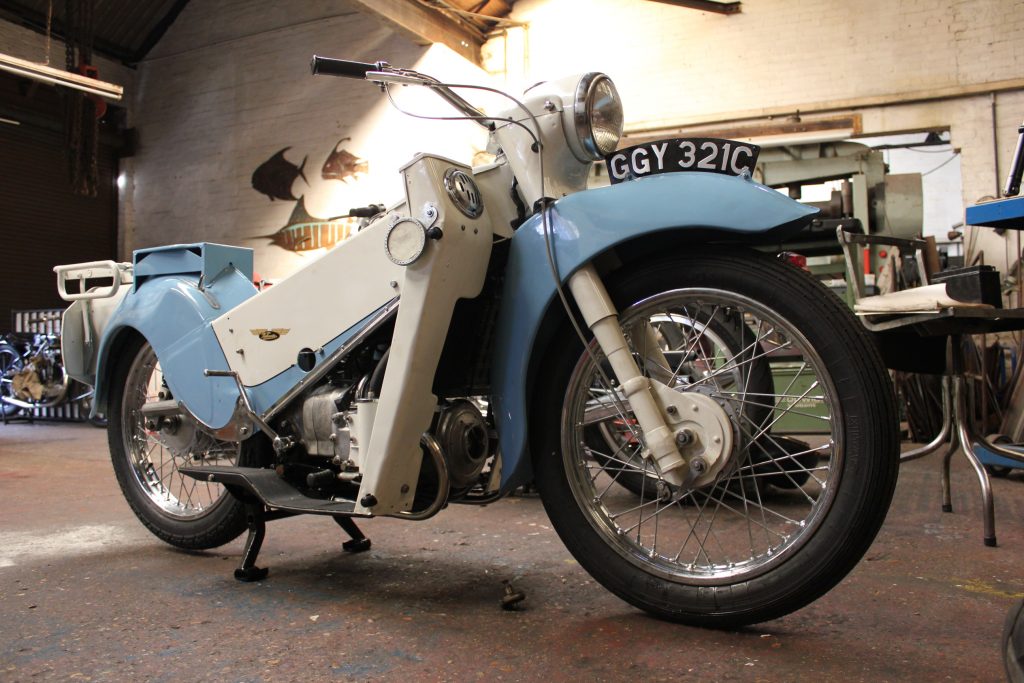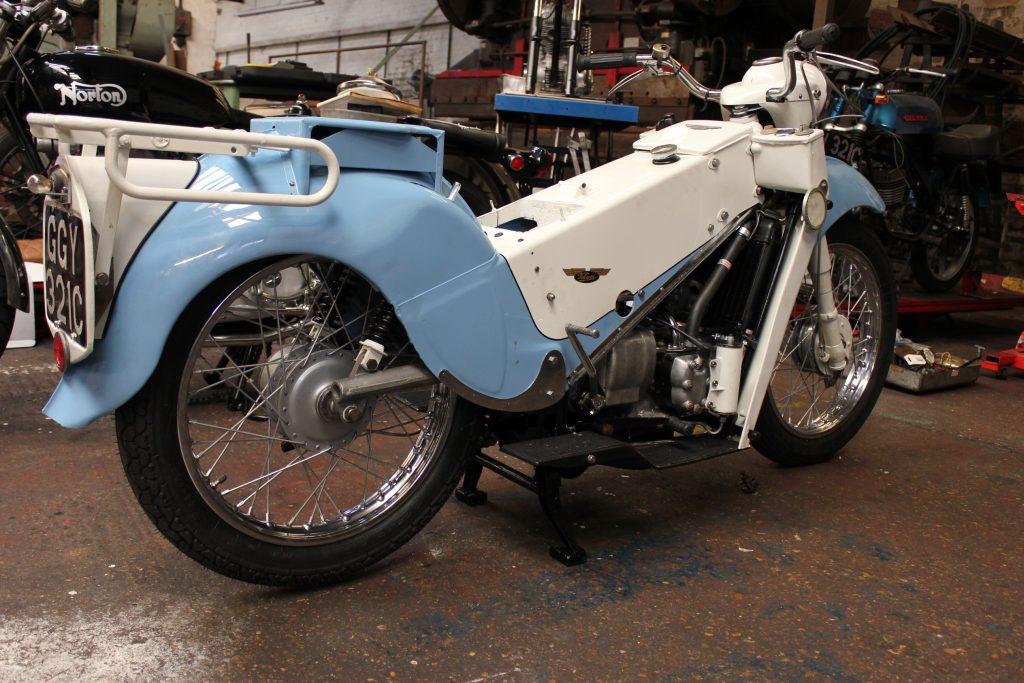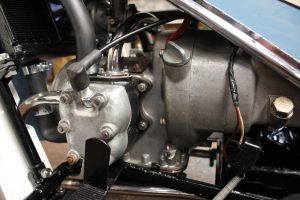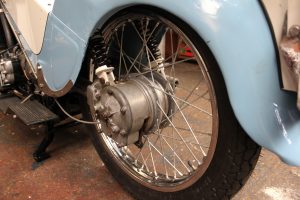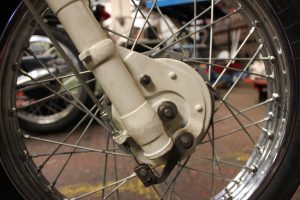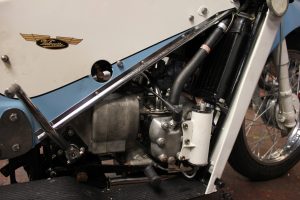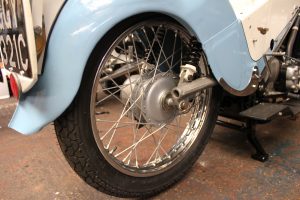The LE Velocette found itself in the workshop after a phone call explaining that the chap who he was sharing the rebuild with had passed away and he held the knowledge on how to put it all back together. I was saddled with the job of putting it all back in an orderly usable fashion with very little information. without being armed with a workshop manual which is almost useless if I had one. The manual was of some use in as much as it told me to build the engine up to the rad and footboards and then lower the body on top of the rebuil, vertically aligning all of the mounting holes. This wasn’t particularly difficult to do but it cannot be carried out by yourself unless you want some scrapes to the paintwork.
I employed the info supplied in the spares book to put it back together as there is so much text in the service manual and it doesn’t cover all parts. When you have got the shell mounted to the engine mounting bracket and such, you will find it tricky to work on anything else excluding the canopy as there is limited space unless you have a finger like “ET” to hold a nut and washer inside the shell while with the other hand holding a socket driver or screw driver.
Make sure you know how to build one of these Velos, if not the best port of call would be from a previous restorer/owner or me. the spares manual will only give you an indication of where parts go but it will have to go together, Haynes manuals with there pictorial wealth do not cover Velocette LE or other uncommon models. So you will have to wing it sometime and fall on some ones mechanical sense on how it goes together.
I put the cables in last and ended up wrestling the control cables into place it isn’t to tyre some but attention will have to be paid in there routing. The wiring harness is a different matter as it is difficult to fit and route.
I feel I have to give the under powder and undersized engine a little bit of a slating even though it drew an amount of respect when an officer of the law was using the machine, how Velocette pulled this off, I don’t know! As from comments from past owners it couldn’t pull the skin off a rice pudding. It definitely wasn’t built to be a work hours but trust a steed to uphold the traffic laws. The steed was chosen for its wealth of panelling that could take a radio and a lot of flashing lights and a packed lunch in the seat in a flop top compartment.
The LE found favour in the Australian states and New Zealand and South Africa so it obviously made a global statement off its own back rather than what the Velocette sales man had to sell. So somehow this little bike sold itself and had something special to give to the world wide market. Reliability was its strength and it was comparatively comfortable to what was on offer in the day. Although there wasn’t much else on the market to compete with Velo adjustable rear suspension.
A mate of mine came to the factory and noticed the partially built velo in light blue and off white paintwork with a little chrome and a pinch of black pin striping this differentiates the pale shades, he told me a story “As part of the tonup crew “popular racers and musicians” numbering 8 in the day, on a summers evenings they could be seen hammering down so and so road breaking all the road regulations, he was spotted by a copper on his Noddy bike who intern waved them down, having stopped at a suitable safe place on the side of the road about a quarter of a mile down the road where he had spotted us, we waited for him to see what his verdict was going to be, He eventually pulled up behind the group and passed judgement and let us go with a warning “If I ever catch you again, you’ll be nicked ” he said, but to be more accurate he should have said “If you ever let me catch up to you again, you’ll be nicked”. The bikes earned there name from the situation that a higher ranking officer would be met by a noddy bike copper astride his velo “LE” with gauntlets fitted to his mitts, when passing a higher ranking offices the rider was to give a nod rather than a catastrophic solute. this is where the LE gets a tribe of followers from, breading off the memories of the past as I can’t see anybody younger than 50 holding an affinity with the “LE”” .
I would love to know the build sequence or to see something written in stone on how to do a rebuild so as to make it a less daunting subject for a learner to undertake and lose heart and bruise his or hers ventures on the project or future project, the restoration is not for the learner as your better off getting a Honda CB 125 or some other Jap single to stand you in good stead for the future. Cables in the correct positions and the wiring harness knitted into the underbelly of the bikes canopy and all the switches in position and plugged into the wiring loom ready for testing.
“WOW” The horn works and yes the tail camp works but not the stop lamp, check bulb “Ok”, Check wiring “Ok”, check continuity through break light switch “Ok”. Turn ignition on and all lights work including break light. The owner says everything is there, all nuts, bolt, washers. No points plate, no condenser, no battery cover, no clear tail light number plate illuminator plastic. There are not major parts but the contact breaker set is a bit tricky as all suppliers seem to be sold out but Hawkshaw motorcycles seemed to have one in stock.
On inspection of the engine I noticed that the usual oil pressure adjuster that was designed and fitter in the 1920 for Velos was still here on this machine. Why oh why have we come this far to find that manual settings of oil pressure is or should be out of the window or the trash, If you can carry out a restoration on any Velocette I think you are competent to work easily on any Japanese or Italian engine with easy. Velo engines will stand you in good stead for the ease of working on anything else. Velo engines and all there idiosyncrasies make you see how invaluable it is. Don’t get me wrong, I love working on Velos as I have the long term, built up, knowledge and I know how to make them work and perform to there best.

